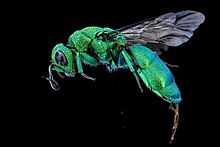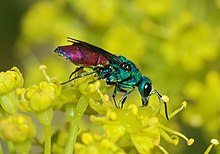Cuckoo wasp
| Cuckoo wasps Temporal range:
| |
|---|---|

| |
| Scientific classification | |
| Domain: | Eukaryota |
| Kingdom: | Animalia |
| Phylum: | Arthropoda |
| Class: | Insecta |
| Order: | Hymenoptera |
| Superfamily: | Chrysidoidea |
| Family: | Chrysididae Latreille, 1802 |
| Subfamilies | |
Commonly known as cuckoo wasps or emerald wasps, the
Nomenclature

The term "cuckoo wasp" refers to the cuckoo-like way in which wasps in the family lay eggs in the nests of unrelated host species.[1] The term is also used for some wasps outside of the family, such as Sapyga louisi.[4]
Chrysididae, the scientific name of the family, refers to their shiny bodies and is derived from Greek chrysis, chrysid-, "gold vessel, gold-embroidered dress", plus the familial suffix -idae. The common names of many species pay similar tribute to their appearance: jewel wasp, gold wasp, emerald wasp, ruby wasp and so on (cf. French guêpe de feu, "fire-wasp", and German / Dutch Goldwespe / goudwesp, "gold-wasp").[5]
Ecology and behavior

Members of the largest subfamily,
and cannot fold up into a ball.Chrysidids are always solitary. They fly mainly in the hottest and driest months of summer in subtropical and Mediterranean climates. They favor dry areas and sandy soils; many species are confined to a narrow type of microhabitat where adults may rest or find hosts to parasitize, for example on bare soil or on dead wood where other solitary wasps have their nest holes. Some species visit flowers such as of the Apiaceae, Asteraceae and Euphorbiaceae.[5]
Evolution
The fossil record of the group is fragmentary, the oldest fossil known being from the lower Aptian Turga Formation of Russia.[6] Other Cretaceous specimens are known from the Albian-Cenomanian amber of France,[7] a Cenomanian limestone in Morocco.[8] The upper Santonian Taimyr amber of Russia[9] and the upper Campanian Canadian amber.[10]
References
- ^ a b c Agnoli, Gian Luca; Rosa, Paolo (20 September 2013). "Chrysidid generalities". Chrysis.net. Retrieved 9 March 2015.
- ^ Agnoli, Gian Luca; Rosa, Paolo (20 September 2013). "Chrysidid coloration". Chrysis.net. Archived from the original on 28 December 2017. Retrieved 16 June 2015.
- ^ Pauli, Thomas; Castillo‐Cajas, Ruth (25 August 2018). "Phylogenetic analysis of cuckoo wasps (Hymenoptera: Chrysididae) reveals a partially artificial classification at the genus level and a species‐rich clade of bee parasitoids". Systematic Entomology. 44 (2): 322–335. .
- ^ "Sapyga louisi Species Information". BugGuide.net. Retrieved 2021-05-28.
- ^ a b Agnoli, Gian Luca; Rosa, Paolo (17 March 2013). "Chrysidids: Family overview". Chrysis.net. Retrieved 9 March 2015.
- ^ A. P. Rasnitsyn. 1990. Pozdne-Mezozoyskie Nasekomye Vostochnogo Zabaykal'ya. Akademiya Nauk SSSR, Trudy Paleontologicheskogo Instituta 239:177-205
- .
- ISSN 0195-6671.
- ^ H. E. Evans. 1973. Cretaceous aculeate wasps from Taimyr, Siberia (Hymenoptera). Psyche 80:166-178
- ^ H. E. Evans. 1969. Three new Cretaceous aculeate wasps (Hymenoptera). Psyche 76:251-261
External links
- Western Australian Museum - Cuckoo Wasp factsheet
- Chrysis. net a picture rich and very informative site
- Family Chrysididae - Cuckoo Wasps at Bugguide, images and information.
- Chrysididae Identification Guide An online guide to the Chrysidids of Eastern North America
- Hymis de Images (=Bilder)
